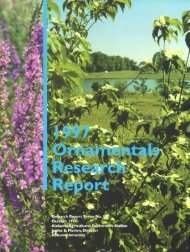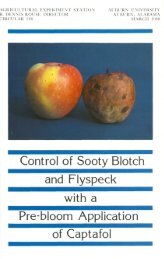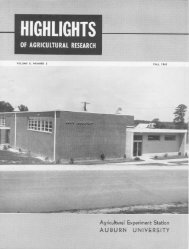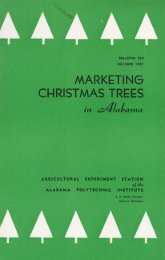FALL TRIALS 1998 VEGETABLE VARIETY - Auburn University
FALL TRIALS 1998 VEGETABLE VARIETY - Auburn University
FALL TRIALS 1998 VEGETABLE VARIETY - Auburn University
You also want an ePaper? Increase the reach of your titles
YUMPU automatically turns print PDFs into web optimized ePapers that Google loves.
<strong>FALL</strong> <strong>1998</strong> <strong>VEGETABLE</strong> <strong>VARIETY</strong> <strong>TRIALS</strong> - 23<br />
<strong>FALL</strong> <strong>1998</strong> <strong>VEGETABLE</strong> <strong>VARIETY</strong> <strong>TRIALS</strong><br />
23<br />
Hot Peppers<br />
Return to Trials<br />
Eric Simonne, Edgar Vinson, Bobby Boozer, Arnold Caylor, and Jim Pitts<br />
Hot pepper varieties trials were conducted at the<br />
Chilton Area Horticulture Station (CAHS) in Clanton and<br />
North Alabama Horticultural Station (NAHS) in Cullman<br />
(Tables 1 and 2). At both locations, hot peppers were<br />
planted in four-foot-long, double row plots with a withinrow<br />
spacing of 12 inches. Plants were grown on black<br />
plastic and drip irrigation was used. Beds were fumigated<br />
with methyl bromide at a rate of 200 pounds per<br />
acre on April 24 at CAHS and April 27 at NAHS. Peppers<br />
were transplanted on May 1 at CAHS and May 16<br />
at NAHS.<br />
At CAHS, fertilization consisted of a pre-plant application<br />
of 13-13-13. After planting, Calcium nitrate<br />
[Ca(NO3) 2] and 20-20-20 were injected alternatively once<br />
a week beginning May 13 and ending August 7. Fungicides<br />
used were Kocide (at a rate of two pounds per acre)<br />
on May 14, May 26, June 8, June 23, July 15, July 24,<br />
and July 29; Manex (at a rate of 1.5 quarts per acre) on<br />
May 14, May 26, June 8, June 23, and July 15; Manzate<br />
(at a rate of three pounds per acre on July 29; and Dithane<br />
(at a rate of 2.5 pounds per acre) on July 24. Insect control<br />
was provided by applications of Thiodan (rates of<br />
1.5 to 3.2 pounds per acre) on May 14, May 26, and<br />
June 23; Lannate (at a rate of one quart per acre) on July<br />
15; Imidan (at a rate of 1.5 pounds per acre) on July 24<br />
and July 29; and, Monitor (at a rate of one quart per<br />
acre) on June 8.<br />
At NAHS, preplant fertilization consisted of a preplant<br />
application of 80 pounds per acre of N as ammonium<br />
nitrate. Beginning after transplanting and through<br />
final harvest, hot peppers were fertilized with weekly<br />
injections alternatively of calcium nitrate and ammonium<br />
nitrate at a rate of five pounds of N per acre for each<br />
injection. This provided a total of 140 pounds of N per<br />
acre.<br />
Fungicides used were Bravo 720 (at a rate of two<br />
pints per acre) on June 3 and June 7; Dithane F-45 (at a<br />
TABLE 1. RATINGS OF 1997 HOT PEPPERS<br />
<strong>VARIETY</strong> <strong>TRIALS</strong>'<br />
Location CAHS NAHS<br />
Weather 5 5<br />
Fertility 5 5<br />
Irrigation 5 5<br />
Pests 5 5<br />
Overall 5 5<br />
'See introduction for a description of rating scales.<br />
rate of 2.4 quarts per acre) on June 18, June 21, June 28,<br />
and July 3; and Kocide 101 (at a rate of three pounds per<br />
acre) on June 18, June 21, and July 3. Insect control<br />
consisted of applications of Dimethoate (at a rate of twp<br />
pints per acre) on June 7; Asana XL (at a rate of 9.6<br />
ounces per acre) on June 3, June 7, June 21, July 3, July<br />
12, July 19, July 26, and August 2; Thiodan (at a rate of<br />
2.5 pounds per acre) on July 12; and, Lannate (at a rate<br />
of three pints per acre) on July 19, July 26, and August<br />
2.<br />
Peppers were harvested four times beginning July<br />
13 at CAHS, and June 4, June 28, August 5, and Augustl7<br />
at NAHS. Early yield, total yield, and the weight<br />
of 25 pods were determined (Table 3).<br />
The main differences in hot pepper varieties were<br />
pod type and pungency. Complete variety recommendations<br />
can be found in the Alabam Cooeprative Extension<br />
System circular ANR 1041 "Pepper varieties for Alabama'."<br />
In the cayenne type, 'Messilla' had the highest<br />
yields. Yields of 'Thai Dragon' were lower because of<br />
small fruits. No significant differences were found among<br />
the yields ofjalopeno varieties at CAHS. 'Mitla' is presently<br />
the standard variety in that group. Top jalapeno<br />
varieties were 'Picante' at CAHS and 'Peco' at NAHS.<br />
No bacterial leaf spot was present in either test.
















